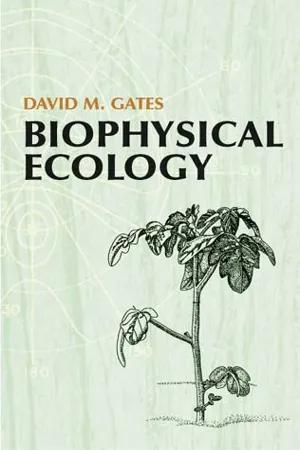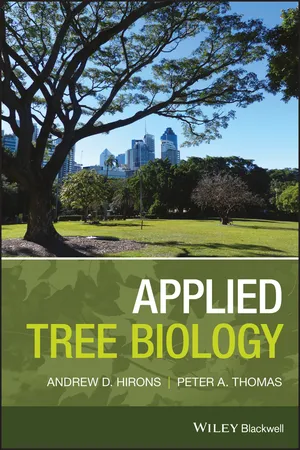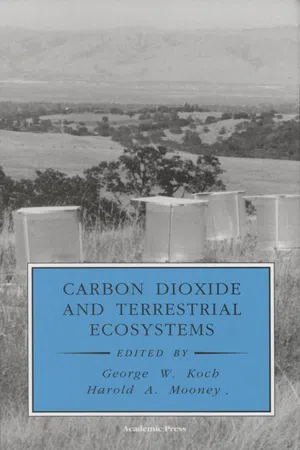Biological Sciences
Rate of Photosynthesis
The rate of photosynthesis refers to the speed at which plants convert light energy, carbon dioxide, and water into glucose and oxygen. It is influenced by factors such as light intensity, temperature, and the availability of water and carbon dioxide. Understanding the rate of photosynthesis is crucial for studying plant growth, productivity, and the global carbon cycle.
Written by Perlego with AI-assistance
Related key terms
Related key terms
1 of 4
Related key terms
1 of 3
4 Key excerpts on "Rate of Photosynthesis"
- eBook - ePub
- Wenhao Dai, Wenhao Dai(Authors)
- 2019(Publication Date)
- CRC Press(Publisher)
2 assimilation in chilling-tolerant C4 plants at temperatures < 20°C; however, it is uncertain that Rubisco capacity is still the limiting factor when temperatures are elevated. Sage and Kubien’s review (2007) pointed out that a better understanding of plant response to temperature stress will put us in a better position to predict and mitigate the effects of global climatic change on photosynthesis in higher plants.3.3 Respiration
Plants need energy and carbon skeletons to sustain their growth and development. As discussed in the previous part of this chapter, plants capture and convert light energy into chemical energy through photosynthesis. The captured energy is stored in the plant as complex compounds, such as sugar, starch, protein, etc. The process plants use to release energy is called respiration.3.3.1 Aerobic respiration
Aerobic respiration is expressed as:C 6H12O 6+ 6O 2+ 6H 2O → 6+ 12CO2H 2O + Energy36 ATPIn aerobic respiration, the organic molecule glucose is oxidized to release energy (ATP) in the presence of O2 . The O2 itself is reduced to form H2 O, and the carbon atoms of glucose are released as CO2 . The energy released from respiration is available to the plant in the form of adenosine triphosphate (ATP) that is involved in almost all biological processes in living plant cells.There are four major stages in the aerobic respiration process. The first stage is glycolysis in which one 6C-glucose is split into two 3C-pyruvates. Glycolysis occurs in the cytosol and can be seen in all living cells. In plants, glucose is derived from sucrose (12C) and other carbohydrates, such as starch. A series of enzymes are involved in the process of glycolysis (Figure 3.2 - eBook - ePub
- David M. Gates(Author)
- 2012(Publication Date)
- Dover Publications(Publisher)
3 -type plants have photorespiration.It has been shown by Decker (1959), Holmgren and Jarvis (1967), Hew et al. (1969), and Jackson and Volk (1970) that photorespiration increases with increasing light intensity. Hofstra and Hesketh (1969) indicate that the temperature dependence of photorespiration probably follows the temperature response of photosynthesis, although according to Jackson and Volk (1970), this may not be true at temperatures above the photosynthetic optimum. Photorespiration increases with increasing oxygen concentration according to Forrester et al. (1966).Internal CO 2 Concentration
If one measures net photosynthetic rate as a function of carbon dioxide concentration in the air outside a leaf, conversion of this function to that relating photosynthesis to carbon dioxide concentration in the intercellular air spaces inside the leaf is straightforward. The procedure involves measuring the rate of loss of water vapor, or the transpiration rate E , and deriving the water-vapor resistance r e as given by(14.22)when the leaf temperatureT, air temperature T a , and relative humidity h are measured. The quantity s d (T) is the water-vapor density at saturation as a function of leaf temperature, and s d a (T a ) is the water-vapor density of the air at saturation as a function of air temperature. Since all quantities except r are known, one can solve for r . (This analysis depends on the air movement across the leaf surface being vigorous enough to reduce the boundary-layer resistance to a small value.) When r for water vapor is determined, this value then gives the resistance R 1 to carbon dioxide since R 1 = 1.56r . The quantity 1.56 is the ratio of the diffusion coefficients of H2 O and CO2 - eBook - ePub
- Andrew Hirons, Peter A. Thomas(Authors)
- 2017(Publication Date)
- Wiley-Blackwell(Publisher)
(Box 7.1) .Box 7.1 Light and Photosynthesis
Although we commonly understand photosynthesis to be driven by sunlight, it is more precise to say that it is driven by solar radiation between 400 and 700 nm in wavelength: referred to as photosynthetically active radiation (PAR). In practice, the availability of light is measured by plant biologists as photosynthetic photon flux density (PPFD, µmol m–2 s–1 ), because this is a good measure of the quantity of solar radiation relevant to photosynthesis.Strictly speaking, PPFD measures the number of photons or quanta arriving at the plant with the units of µmol of quanta per square metre per second (µmol quanta m–2 s–1 ), which by convention is abbreviated to µmol m–2 s–1 . To add confusion, photosynthetic carbon assimilation is measured in µmol carbon dioxide per m2 leaf area per second (µmol CO2 m–2 s–1 ), which, unfortunately, is also abbreviated to µmol m–2 s–1 . Care is therefore needed!Numerous factors affect the proportion of light that reaches tree crowns. Latitude, climate (especially cloudiness), time of day and neighbouring vegetation (or objects) that cast shade on to leaves all affect the quantity or quality of light available for photosynthesis. In forest environments, the canopy modifies the quantity and quality of light for any plants growing in the understorey. Within a leafless temperate deciduous forest, 50–80% of full sunlight reaches the forest floor. When the canopy closes, this is often reduced to less than 10% and, in dense beech Fagus forests, can be as little as 0.2–0.4% (Barnes et al. 1998). This means that trees growing in the open or in a dominant position within the forest canopy may grow in 100% full sunlight (a PPFD greater than 2000 µmol m–2 s–1 ), while some understorey species may have to cope with less than 0.25% full sunlight (around 5 µmol m–2 s–1 ). Generalisations are difficult to make as light transmission through forests is highly complex (see Chapter 3 ), but the crown architecture of the dominant species will influence how much light reaches the understorey. On windy days, more light may get through because of the movement of the branches above; on cloudy days, the relative percentage of light reaching the ground is higher than on clear days because the cloudy sky radiates light from all directions. Light quality also changes in the understorey as leaves within the forest canopy absorb much of the red and blue light that is useful for photosynthesis (Valladares et al - eBook - ePub
- George W. Koch, Jacques Roy(Authors)
- 1995(Publication Date)
- Academic Press(Publisher)
−1 ]. Mathematically, it can be expressed as(2)For simplicity, P (x,y,t ) is abbreviated as P hereafter. For 1 unit change in the global atmospheric CO2 concentration (C a , ppm), the rate of P G change (Gt ppm−1 yr−1 ) is(3)where is a leaf-level factor (ppm−1 ) defined as(4)The l factor denotes the relative leaf photosynthetic response to a 1 ppm C a change.The vast majority of all terrestrial plants share a C3 photosynthetic pathway ( Bowes, 1993 ). Leaf photosynthesis of C3 plants, which is usually limited either by electron transport or by ribulose-l,5-bisphosphate carboxylase/oxygenase (rubisco) activity, is predicted by the well-establishedFarquhar et al. (1980)model. When photosynthesis is limited by electron transport, leaf photosynthetic carbon influx (P 1 ) is(5)where J is the electron transport rate (μmol m−2 s−1 ), C i is the intercellular CO2 concentration (ppm), and Γ is the CO2 compensation point without dark respiration (ppm). With the assumption thatCiis proportional to C a as,(6)the corresponding factor is(7)Parameter J is eliminated from Eq. (7) because 1 is a measure of relative response.When photosynthesis is limited by rubisco activity, leaf carbon influx (P 2 ) is(8)where V cmax is the maximum carboxylation rate (μmol m−2 s−1 ) and K is a coefficient (ppm) associated with enzyme kinetics. The corresponding factor is(9)Parameter V cmax is eliminated from Eq. (9) because is also a measure of relative response. Because the physiological process of electron transport is less sensitive to CO2 concentration than is carboxylation, and define the lower and upper limits, respectively, of the
Index pages curate the most relevant extracts from our library of academic textbooks. They’ve been created using an in-house natural language model (NLM), each adding context and meaning to key research topics.
Explore more topic indexes
Explore more topic indexes
1 of 6
Explore more topic indexes
1 of 4



